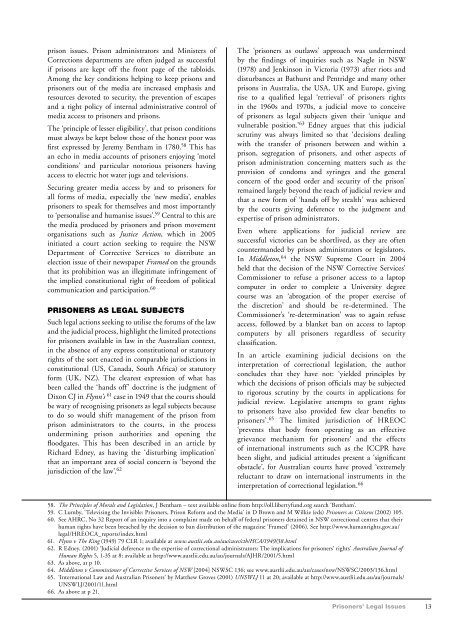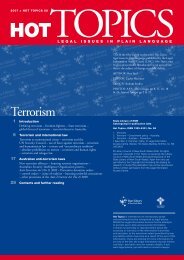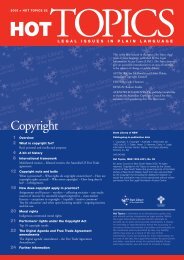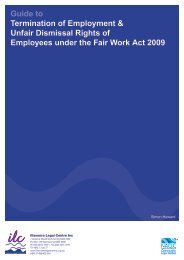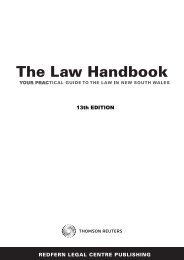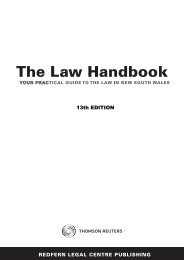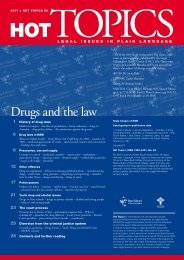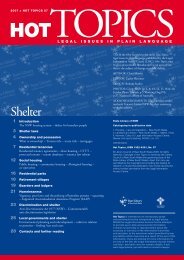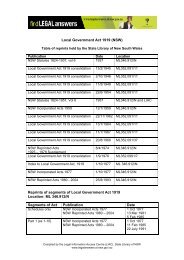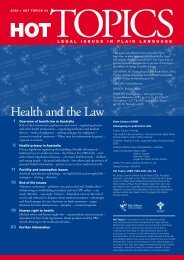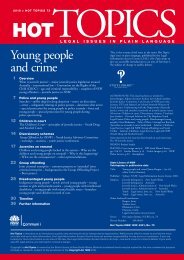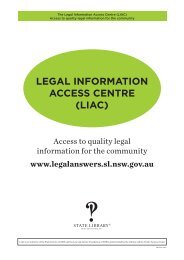Prisoners - Legal Information Access Centre - NSW Government
Prisoners - Legal Information Access Centre - NSW Government
Prisoners - Legal Information Access Centre - NSW Government
Create successful ePaper yourself
Turn your PDF publications into a flip-book with our unique Google optimized e-Paper software.
prison issues. Prison administrators and Ministers of<br />
Corrections departments are often judged as successful<br />
if prisons are kept off the front page of the tabloids.<br />
Among the key conditions helping to keep prisons and<br />
prisoners out of the media are increased emphasis and<br />
resources devoted to security, the prevention of escapes<br />
and a tight policy of internal administrative control of<br />
media access to prisoners and prisons.<br />
The ‘principle of lesser eligibility’, that prison conditions<br />
must always be kept below those of the honest poor was<br />
first expressed by Jeremy Bentham in 1780. 58 This has<br />
an echo in media accounts of prisoners enjoying ‘motel<br />
conditions’ and particular notorious prisoners having<br />
access to electric hot water jugs and televisions.<br />
Securing greater media access by and to prisoners for<br />
all forms of media, especially the ‘new media’, enables<br />
prisoners to speak for themselves and most importantly<br />
to ‘personalise and humanise issues’. 59 Central to this are<br />
the media produced by prisoners and prison movement<br />
organisations such as Justice Action, which in 2005<br />
initiated a court action seeking to require the <strong>NSW</strong><br />
Department of Corrective Services to distribute an<br />
election issue of their newspaper Framed on the grounds<br />
that its prohibition was an illegitimate infringement of<br />
the implied constitutional right of freedom of political<br />
communication and participation. 60<br />
prisOners As legAl suBjecTs<br />
Such legal actions seeking to utilise the forums of the law<br />
and the judicial process, highlight the limited protections<br />
for prisoners available in law in the Australian context,<br />
in the absence of any express constitutional or statutory<br />
rights of the sort enacted in comparable jurisdictions in<br />
constitutional (US, Canada, South Africa) or statutory<br />
form (UK, NZ). The clearest expression of what has<br />
been called the ‘hands off’ doctrine is the judgment of<br />
Dixon CJ in Flynn’s 61 case in 1949 that the courts should<br />
be wary of recognising prisoners as legal subjects because<br />
to do so would shift management of the prison from<br />
prison administrators to the courts, in the process<br />
undermining prison authorities and opening the<br />
floodgates. This has been described in an article by<br />
Richard Edney, as having the ‘disturbing implication’<br />
that an important area of social concern is ‘beyond the<br />
jurisdiction of the law’. 62<br />
The ‘prisoners as outlaws’ approach was undermined<br />
by the findings of inquiries such as Nagle in <strong>NSW</strong><br />
(1978) and Jenkinson in Victoria (1973) after riots and<br />
disturbances at Bathurst and Pentridge and many other<br />
prisons in Australia, the USA, UK and Europe, giving<br />
rise to a qualified legal ‘retrieval’ of prisoners rights<br />
in the 1960s and 1970s, a judicial move to conceive<br />
of prisoners as legal subjects given their ‘unique and<br />
vulnerable position.’ 63 Edney argues that this judicial<br />
scrutiny was always limited so that ‘decisions dealing<br />
with the transfer of prisoners between and within a<br />
prison, segregation of prisoners, and other aspects of<br />
prison administration concerning matters such as the<br />
provision of condoms and syringes and the general<br />
concern of the good order and security of the prison’<br />
remained largely beyond the reach of judicial review and<br />
that a new form of ‘hands off by stealth’ was achieved<br />
by the courts giving deference to the judgment and<br />
expertise of prison administrators.<br />
Even where applications for judicial review are<br />
successful victories can be shortlived, as they are often<br />
countermanded by prison administrators or legislators.<br />
In Middleton, 64 the <strong>NSW</strong> Supreme Court in 2004<br />
held that the decision of the <strong>NSW</strong> Corrective Services’<br />
Commissioner to refuse a prisoner access to a laptop<br />
computer in order to complete a University degree<br />
course was an ‘abrogation of the proper exercise of<br />
the discretion’ and should be re-determined. The<br />
Commissioner’s ‘re-determination’ was to again refuse<br />
access, followed by a blanket ban on access to laptop<br />
computers by all prisoners regardless of security<br />
classification.<br />
In an article examining judicial decisions on the<br />
interpretation of correctional legislation, the author<br />
concludes that they have not: ‘yielded principles by<br />
which the decisions of prison officials may be subjected<br />
to rigorous scrutiny by the courts in applications for<br />
judicial review. Legislative attempts to grant rights<br />
to prisoners have also provided few clear benefits to<br />
prisoners’. 65 The limited jurisdiction of HREOC<br />
‘prevents that body from operating as an effective<br />
grievance mechanism for prisoners’ and the effects<br />
of international instruments such as the ICCPR have<br />
been slight, and judicial attitudes present a ‘significant<br />
obstacle’, for Australian courts have proved ‘extremely<br />
reluctant to draw on international instruments in the<br />
interpretation of correctional legislation. 66<br />
58. The Principles of Morals and Legislation, J Bentham – text available online from http://oll.libertyfund.org search ‘Bentham’.<br />
59. C Lumby, ‘Televising the Invisible: <strong>Prisoners</strong>, Prison Reform and the Media’ in D Brown and M Wilkie (eds) <strong>Prisoners</strong> as Citizens (2002) 105.<br />
60. See AHRC, No 32 Report of an inquiry into a complaint made on behalf of federal prisoners detained in <strong>NSW</strong> correctional centres that their<br />
human rights have been breached by the decision to ban distribution of the magazine ‘Framed’ (2006). See http://www.humanrights.gov.au/<br />
legal/HREOCA_reports/index.html<br />
61. Flynn v The King (1949) 79 CLR 1; available at www.austlii.edu.au/au/cases/cth/HCA/1949/38.html<br />
62. R Edney, (2001) ‘Judicial deference to the expertise of correctional administrators: The implications for prisoners’ rights’ Australian Journal of<br />
Human Rights 5, 1-35 at 8; available at http://www.austlii.edu.au/au/journals/AJHR/2001/5.html<br />
63. As above, at p 10.<br />
64. Middleton v Commissioner of Corrective Services of <strong>NSW</strong> [2004] <strong>NSW</strong>SC 136; see www.austlii.edu.au/au/cases/nsw/<strong>NSW</strong>SC/2003/136.html<br />
65. ‘International Law and Australian <strong>Prisoners</strong>’ by Matthew Groves (2001) U<strong>NSW</strong>LJ 11 at 20; available at http://www.austlii.edu.au/au/journals/<br />
U<strong>NSW</strong>LJ/2001/11.html<br />
66. As above at p 21.<br />
prisoners’ <strong>Legal</strong> issues 13


